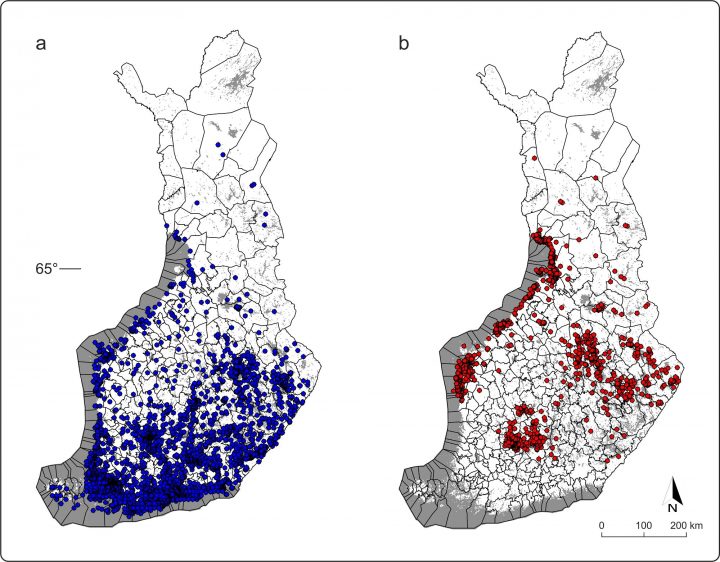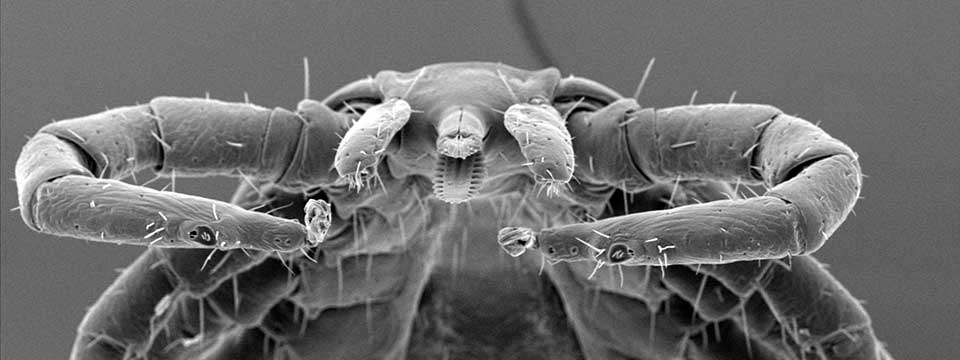Hard ticks in the genus Ixodes, for instance Ixodes ricinus (the sheep or castor bean tick) and Ixodes persulcatus (the taiga tick), have recently increased in abundance in Finland and elsewhere in northern Europe. This has happened in many locations and under different environments, also in urban and suburban areas nearby big cities. Not all of the reasons for these increases have been examined, but a substantial role for the changing climate has commonly been stressed. Shorter and warmer winters, prolonged growing seasons and other climatic changes are suggested to have direct effects on tick and pathogen performance and indirect effects on tick dynamics via density and range shifts in mammalian and avian host animal populations.
Although several tick species are present, at least occasionally, in Finland, only I. ricinus and I. persulcatus are considered as health threats to humans and domestic animals. These two species look superficially similar, and they may occur at same areas and environments. Both species may carry same bacterial, viral and protozoan pathogens, and they also share hosts in nature: e.g. small rodents, hares, deer, raccoon dogs, passerine birds and humans and their companion animals.
Of the tick-borne diseases, borreliosis (= Lyme disease; caused by Borrelia bacteria) and tick-borne encephalitis (TBE; caused by TBE virus) are considered the most serious for public health. The former is treated by antibiotics, whereas people can be vaccinated against TBE, especially in known risk areas.
The research team of the University of Turku investigates Ixodes ticks and tick-borne pathogens using field sampling, citizen surveys and molecular biology tools. See our recent publications below.
See how ticks are sampled using cloth-dragging.
Scientific publications
- Sormunen, J.J. et al. 2025: Ticks and tick-borne pathogens encountered by dogs and cats: a North European perspective. – Transboundary and Emerging Diseases 2025: 5574554.
- Sormunen, J.J. et al. 2025: There goes the neighbourhood— a multi-city study reveals ticks and tick-borne pathogens commonly occupy urban green spaces. – Zoonoses Public Health 72: 313–323.
- Alale, T.Y., et al. 2024: Public knowledge and awareness of tick-borne pathogens and diseases: A cross-sectional study in Ghana. – Current Research in Parasitology & Vector-Borne Diseases 6: 100228.
- Alale, T.Y. et al. 2024: Genomic signatures of hybridization between Ixodes ricinus and Ixodes persulcatus in natural populations. – Ecology and Evolution 14: e11415.
- Sormunen, J.J. et al. 2024: Blood meal analysis reveals sources of tick-borne pathogens and differences in host utilization of juvenile Ixodes ricinus across urban and sylvatic habitats. – Zoonoses and Public Health 71: 442–450.
- Sormunen, J.J. et al. 2023: Crowdsourced tick observation data from across 60 years reveals major increases and northwards shifts in tick contact areas in Finland. – Scientific Reports 13: 21274.
- Sormunen, J.J. et al. 2023: For the people by the people: Citizen science web interface for real-time monitoring of tick risk areas in Finland. – Ecological Solutions and Evidence 4: e12294.
- Sormunen, J.J. et al. 2023: Voles, shrews and red squirrels as sources of tick blood meals and tick-borne pathogens on an island in southwestern Finland. – Ticks and Tick-borne Diseases 14: 102134.
- Kulha, N. et al. 2022: Does environmental adaptation or dispersal history explain the geographical distribution of Ixodes ricinus and Ixodes persulcatus ticks in Finland? – Ecology and Evolution 12: e9538.
- Sormunen, J.J. et al. 2022: Ticks (Acari: Ixodidae) parasitizing migrating and local breeding birds in Finland. – Experimental and Applied Acarology 86: 145–156.
- Sormunen, J.J. et al. 2021: Absence of Francisella tularensis in Finnish Ixodes ricinus and Ixodes persulcatus ticks. – Ticks and Tick-borne Diseases 12: 101809.
- Sormunen, J.J. et al. 2020: Enhanced threat of tick-borne infections within cities? Assessing public health risks due to ticks in urban green spaces in Helsinki, Finland. – Zoonoses and Public Health 67: 822–838.
- Nyrhilä, S. et al. 2020: One out of ten: low sampling efficiency of cloth dragging challenges abundance estimates of questing ticks. – Experimental and Applied Acarology 82: 571–585.
- Sormunen, J.J. et al. 2020: Monitoring of ticks and tick-borne pathogens through a nationwide research station network in Finland. – Ticks and Tick-borne Diseases 11: 101449.
- Sormunen, J.J. et al. 2019: First evidence of Ixodiphagus hookeri (Hymenoptera: Encyrtidae) parasitization in Finnish castor bean ticks (Ixodes ricinus). – Experimental and Applied Acarology 79: 395–404.
- Klemola, T. et al. 2019: High tick abundance and diversity of tick-borne pathogens in a Finnish city. – Urban Ecosystems 22: 817–826.
- Sormunen, J.J. (PhD thesis) 2018: Questing ticks, hidden causes: tracking changes in Ixodes ricinus populations and associated pathogens in southwestern Finland. Annales Universitatis Turkuensis A II 349
- Sormunen, J.J. et al. 2018: The importance of study duration and spatial scale in pathogen detection – evidence from a tick-infested island. –Emerging Microbes & Infections 7: 189.
- Laaksonen, M. et al. 2018: Tick-borne pathogens in Finland: comparison of Ixodes ricinus and I. persulcatus in sympatric and parapatric areas. – Parasites & Vectors 11: 556.
- Laaksonen, M. et al. 2017: Crowdsourcing-based nationwide tick collection reveals the distribution of Ixodes ricinus and I. persulcatus and associated pathogens in Finland. – Emerging Microbes & Infections 6: e31.
- Sormunen, J.J. et al. 2016: Anaplasma phagocytophilum in questing Ixodes ricinus ticks in southwestern Finland. – Experimental and Applied Acarology 70: 491–500.
- Sormunen, J.J. et al. 2016. Tick-borne bacterial pathogens in southwestern Finland. – Parasites & Vectors 9: 168.
- Sormunen, J.J. et al. 2016. Assessing the abundance, seasonal questing activity, and Borrelia and tick-borne encephalitis virus (TBEV) prevalence of Ixodes ricinus ticks in a Lyme borreliosis endemic area in Southwest Finland. – Ticks and Tick-borne Diseases 7: 208–215.
- Mäkinen, J. et al. 2003. Prevalence of granulocytic Ehrlichia and Borrelia burgdorferi sensu lato in Ixodes ricinus ticks collected from Southwestern Finland and from Vormsi Island in Estonia. – Acta Pathologica, Microbiologica et Immunologica Scandinavica 111: 355–362.

Acknowledgements for financial support
- Jane and Aatos Erkko Foundation
- University of Turku Graduate School (Doctoral Programme in Biology, Geography and Geology)
- Turku University Foundation
- Jenny and Antti Wihuri Foundation
- Finnish Cultural Foundation (Varsinais-Suomi Regional Fund)
- Maj and Tor Nessling Foundation
- Academy of Finland
- Lääkintöneuvos Sakari Alhopuro
- Pfizer Inc. (Finland)
- University of Turku
- City of Turku
- Metsähallitus
Contact
- puutiaiset@utu.fi
